5.4.2: West Africa- The Sunjata Story
- Page ID
- 90713
Perhaps the richest extant tradition of epic recitation is to be found among the Mandinka people of West Africa, and their most valued epic is certainly the story of Sunjata, the founder of the ancient Mali Empire. A complete recitation of the Sunjata story can take between six and eight hours. The telling of the story is therefore a remarkable feat in and of itself—all the more so because its words are maintained entirely in the memories of the storytellers. The epic is the property of the jali caste, members of which are responsible for passing it from generation to generation.
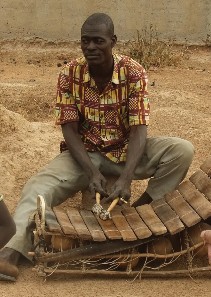
Founded in 1240, the Mali Empire occupied all or part of half a dozen modern West African countries. It flourished until 1645, when conflict over accession to the throne resulted in the collapse of the empire. Although the Mali Empire was large and powerful, its history has largely been told from outside perspectives. This is because its inhabitants did not cultivate written language, instead maintaining knowledge by means of oral transmission—a process that carries into the present day. The Mandinka, who currently number about 32 million, are the descendents of the Mali Empire, and they continue to celebrate their common heritage through story and song.
Mandinkan Social Structure and the Jali
Before we can examine Mandinkan storytelling practices, we need to know something about the people who tell those stories. Traditionally, Mandinkan society was organized according to a caste system, meaning that social roles were determined by birth and were strictly defined. Members of the jali caste were musicians and storytellers, and their role was to serve the aristocratic caste. (You might be familiar with the French term “griot,” which is more widely used in the West, but members of the community generally prefer the term “jali.”) Although the caste system is officially defunct today, it still exerts an influence on modern society, and jali continue to pass their knowledge and skills down through family lines.
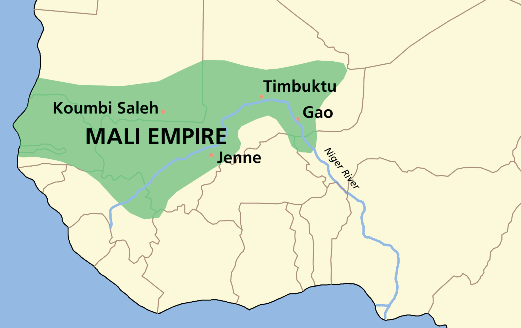
The jali caste was not high ranking, but its members were considered to have special powers and to occupy a unique place in the community. They were considered ritually impure, and were prohibited from wearing the clothes of the aristocracy or sitting on their beds. When they died, they were buried separately from other members of the community. Jali also could not hold political office. At the same time, jali served as advisors to aristocrats and could therefore be very powerful. If a jali was captured in battle, they could not be killed or enslaved, but were expected to serve their captor as they had served their previous master.
The responsibilities of the jali were many. They were musicians, and as such they provided ceremonial music for naming ceremonies, marriages, and agricul- tural celebrations. They also entertained at dances and wrestling matches and sang the praises of the aristocrats they served. However, the primary role of the jali was to maintain and transmit the knowledge and traditions of the commu- nity, including histories, genealogies, proverbs, and laws. If the jali did not fulfill their function, therefore, society itself would disintegrate. Apart from these weighty tasks, the jali also served as moralists, counsellors, spokesmen, public announcers, mediators, mes- sengers, buffoons, porters, tax collectors, and hairdressers.
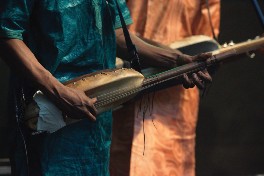
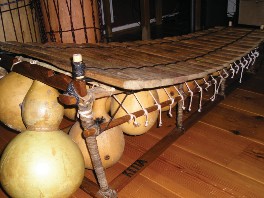
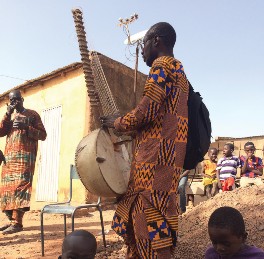
The jali enjoyed dominion over specific musical instruments. These included the ngoni (a small lute made from wood and covered with goat skin), the balafon (a xylophone in which wood keys are strung over gourd resonators), and the kora. The last of these is certainly the most remarkable, and has retained the deepest connection with the jali tradition. The kora is a type of harp lute, the strings of which are suspended above a large resonator made out of a calabash gourd covered with cow skin. The strings are plucked with the thumb and index finger of each hand. All three of these instruments are used to play complex melodic patterns constructed out of complementary interlocking parts— parts that, at least on the balafon and kora, are each played with one of the two hands.
Traditionally, these instruments were only played by men. Boys would begin to learn from their fathers or uncles, and a jali’s musical education would culminate in the building of his own instrument. A jali also needed to master the tuning systems, which are different for each instrument and quite unlike anything found in Europe. A result of this is that West African music can sound out of tune, although in fact each pitch is carefully positioned. Female jali were musicians too, but they were only trained to sing and play a percussion instrument called the neo. Today, of course, many women excel as performers on all of these instruments.
The Sunjata Story
The Sunjata story is well known, for it has been frequently published in both novel and verse form over the past century and is often included in world literature courses. It constitutes a mythologized retelling of how the historical figure Sunjanta unified the Mali Empire and became its first ruler. According to the epic, Sunjata— whose glorious conquests had been foretold by a soothsayer—was the son of the Mandinkan king’s second wife. As a child, however, Sunjata could not walk, and when the king died it was his half brother who ascended to the throne. Sunjata and his mother were exiled and found a new home in the Mema kingdom, where Sunjata grew strong and gained such widespread support that he was designated heir to the throne. When the Mandinka kingdom was attacked by a malicious power, Sunjata came to the rescue while his half-brother fled in fear. Sunjata’s coalition of small kingdoms defeated the aggressor and resulted in the founding of the Mali Empire.
There are not many recordings of the Sunjata story in existence, for it is carefully guarded. The epic is often related as part of religious ceremonies, and it is believed to bring blessings to all who hear it. Listeners, however, are prohibited from recording these performances. The recordings that are available have been made at formal concerts or recording sessions, and therefore lack many of the elements that would characterize a more authentic performance. These recordings tend to be brief, both because they often omit episodes from the story and because they lack the participatory embellishments that bring the story to life when it is shared in a communal context. Listeners, for example, might join together in singing hymns at appropriate points, or jali might shout out praise songs dedicated to historical figures as they enter the narrative. Participants will also interrupt the story to donate money in return for blessings.
In considering our recordings, therefore, we must be aware that they offer only a glimpse of Sunjata epic recitation as a living practice. Apart from being brief, they are in no way definitive. There are variations in the words that are used to tell the story and even in the events that are related (sometimes, for example, Sunjata and his mother are exiled from the Mali kingdom, while other times they choose to leave for their own safety). The epic is also not always sung to the same melody, nor is the accompaniment stable. The underlying instrumental music might be supplied by kora, balafon, ngoni, or even guitar, and the pattern played by these instruments—known as the kumbengo—can vary in large and small ways.
Comparing Two Renditions of The Sunjata Story
We will begin with a recording made of a 1987 performance in which jali Djelimady Sissoko recites the epic while Sidiki Diabaté accompanies him on the kora. Like all performances, this begins with an instrumental improvisation. At first there is no pulse, but gradually the player settles in to the kumbengo. In this case, we hear the most typical kumbengo for a Sunjata epic recitation, that associated with the Sunjata praise song. The praise song is entirely separate from the epic, but it might be sung during a ritual performance of the epic and the two are closely connected.
|
The Sunjata Story 12. Performance: Djelimady Sissoko, accompanied by Sidiki Diabaté (1987) |
|
13. The Sunjata praise song is musically related to the recitation of the epic. |
The singer enters at the top of his range and then descends down the scale outlined in the accompaniment. This is the typical melodic shape for epic recitation, and it is influenced by the Mandinka language, which is tonal. This means that the inflection of vowel sounds changes the meaning of a word. Because most Mandinka words inflect in a downward direction, setting the words to music naturally produces a descending melody. The vocal ability of a singer is judged in terms of power and confidence. However, the most important quality for a singer to possess is truthfulness. A good singer, therefore, is one whose words are true, regardless of the sound of their voice. The truthfulness of Djelimady Sissoko’s words is confirmed by Sidiki Diabaté, who fulfills the role of witness by chanting naamu, or “indeed,” at the end of every sentence. (If the jali makes a mistake in telling the story, which frequently occurs, the witness must correct it.)
The “groove” is an important characteristic of this performance, as is the rhythmic interaction between the singer and kora player. However, these elements are not simple to perceive or explain. While the repetitiveness of the accompaniment makes it obvious that there is a regular pulse, that pulse is constantly shifting. Try tapping your foot along to the music, and you will soon find that you have lost the beat. This is the result of a concept of rhythm that is based on patterns, not European-style meter. West African musicians, for example, do not count beats in the way European musicians do, and they do not recognize a downbeat (the first and strongest pulse in a metrical grouping). Instead, they transform rhythmic patterns in the way that a kaleidoscope transforms images.
This concept of constant transformation is central to the practice of West African instrumentalists. In this recording, the kora player never repeats the kumbengo pattern unchanged for long. Instead, he makes constant alterations to the rhythmic and pitch content, adding syncopations and ornaments of unending variety. He also interjects virtuosic flourishes in between the phrases of the story. Periodically, the singer pauses to allow for an extended kora solo.14 While the basic musical contents of the kumbengo are quite simple, therefore, the work of the kora player is complex and sophisticated.
We will briefly examine a second performance of episodes from the Sunjata story for the sake of comparison.15 This rendition, recorded in 2014, is accompanied by the balafon. Although the balafon, which is a percussion instrument, is quite different from the kora in terms of construction, playing technique, and sound, it executes exactly the same function. Again, the performance opens with an extended solo by the balafon player, Fodé Lassana Diabaté, who eventually settles into a kumbengo that is very similar to that played on the kora. Again, the balafon player constantly alters his accompaniment, adding rhythmic and melodic variations. And again, he occasionally takes the opportunity to improvise extended instrumental solos in between sections of the recited text.
|
This is one of many kora solos that interrupt the jali’s recitation. |
|
The Sunjata Story. Performance: Hawa Kassé Mady Diabaté, accompanied by Fodé Lassana Diabaté (2014) |
The work of the singer, Hawa Kassé Mady Diabaté, can also be compared to the previous recording. Most of her phrases begin high in her range and descend down the scale. She regularly enters during different parts of the kumbengo and does not align her phrases with the accompaniment. And her vocal production is powerful and commanding. She periodically plays a simple percussion instrument, known as a shekere, that consists of a gourd with a beaded cover.
Although this rendition is excellent, its context—amplified on a stage before a silent audience—is far removed from that in which the Sunjata story has thrived for eight hundred years. Jali storytelling is meant to be highly participatory, and this epic only lives when it is endorsed and enriched by the community.


